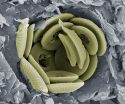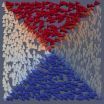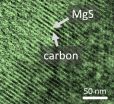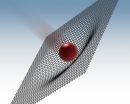(Press-News.org) A study of ancient marine algae, led by the University of Southampton, has found that climate change affected their growth and skeleton structure, which has potential significance for today's equivalent microscopic organisms that play an important role in the world's oceans.
Coccolithophores, a type of marine algae, are prolific in the ocean today and have been for millions of years. These single-celled plankton produce calcite skeletons that are preserved in seafloor sediments after death. Although coccolithophores are microscopic, their abundance makes them key contributors to marine ecosystems and the global carbon cycle.
There is, therefore, much current interest in how coccolithophore calcification might be affected by climate change and ocean acidification, both of which occur as atmospheric carbon dioxide increases.
The research, published in Nature Communications, examined preserved fossil remains of coccolithophores from a period of climate warming and ocean acidification that occurred around 56 million years ago - the Paleocene Eocene Thermal Maximum (PETM) - and provides a much-needed long-term perspective of coccolithophore response to ocean acidification.
Dr Sarah O'Dea, from Ocean and Earth Science at the University of Southampton and lead author of the study, says: "Our results show that climate change significantly altered coccolithophore calcification rates at the PETM and has the potential to be just as significant, perhaps even more so, today. Ultimately then, it is the factors that influence where species live, their abundance, how fast they grow and their ability to adapt to environmental change that is likely to control future coccolithophore calcite production."
The study investigated two key PETM coccolithophores, Coccolithus pelagicus and Toweius pertusus, both of which are directly related to species that dominate the modern ocean.
It found that calcification rates of C. pelagicus and T. pertusus halved during the PETM, due to changes in environmental factors that influenced their growth. The response of each species was, however, different, and involved intervals of slowed growth in C. pelagicus and an overall reduction in the size of the skeletal components - coccoliths - in T. pertusus. Intriguingly though, there was very little evidence for any response to ocean acidification, other than perhaps a slight thinning of C. pelagicus coccoliths.
Dr Samantha Gibbs, from Ocean and Earth Science at the University of Southampton, who was Dr O'Dea's PhD supervisor and co-author of the study, says: "A key objective was to record calcification in fossil coccolithophores in a way that enabled direct comparison with measurements from living specimens. Our novel technique involved analysing coccolithophore skeletal remains and applying observations from modern specimens to estimate, for the first time, calcification rates of fossil coccolithophores."
INFORMATION:
The study, which also involved researchers from the National Oceanography Centre, Southampton and University College London, was funded by a Natural Environment Research Council (NERC) studentship to Dr O'Dea and a Royal Society Research Fellowship to Dr Gibbs, Senior Research Fellow in Ocean and Earth Science at the University of Southampton, with additional support by the UK Ocean Acidification Research Programme. END
"A quantum computer may be thought of as a 'simulator of overall Nature," explains Fabio Franchini, a researcher at the International School for Advanced Studies (SISSA) of Trieste, "in other words, it's a machine capable of simulating Nature as a quantum system, something that classical computers cannot do". Quantum computers are machines that carry out operations by exploiting the phenomena of quantum mechanics, and they are capable of performing different functions from those of current computers. This science is still very young and the systems produced to date are ...
Subliminal visual cues are words, pictures or symbols which are unidentifiable in someone's conscious.
Conducted by Professor Samuele Marcora in collaboration with colleagues at Bangor University, the research discovered that athletes undergoing endurance exercise who were presented with positive subliminal cues, such as action-related words, including 'go' and 'energy', or were shown happy faces, were able to exercise significantly longer compared to those who were shown sad faces or inaction words.
The words and faces appeared on a digital screen - placed in front ...
Researchers at DESY have used high-speed photography to film one of the candidates for the magnetic data storage devices of the future in action. The film was taken using an X-ray microscope and shows magnetic vortices being formed in ultrafast memory cells. Their work, which has been reported by the scientists surrounding Dr. Philipp Wessels of the University of Hamburg in the journal Physical Review B, provides a better understanding of the dynamics of magnetic storage materials. Magnetic memory cells are found in every computer hard drive.
"Our images allow us to observe ...
Group mindfulness treatment is as effective as individual cognitive behavioural therapy (CBT) in patients with depression and anxiety, according to a new study from Lund University in Sweden and Region Skåne. This is the first randomised study to compare group mindfulness treatment and individual cognitive behavioural therapy in patients with depression and anxiety in primary health care.
The researchers, led by Professor Jan Sundquist, ran the study at 16 primary health care centres in Skåne, a county in southern Sweden. They trained two mindfulness instructors, ...
27 November 2014 - Anopheles mosquitoes are responsible for transmitting human malaria parasites that cause an estimated 200 million cases and more than 600 thousand deaths each year. However, of the almost 500 different Anopheles species, only a few dozen can carry the parasite and only a handful of species are responsible for the vast majority of transmissions. To investigate the genetic differences between the deadly parasite-transmitting species and their harmless (but still annoying) cousins, an international team of scientists, including researchers from the University ...
This news release is available in German.
The Helmholtz Institute Ulm (HIU) established by Karlsruhe Institute of Technology (KIT) is pushing research relating to batteries of the next and next-but-one generations: A research team has now developed an electrolyte that may be used for the construction of magnesium-sulfur battery cells. With magnesium, higher storage densities could be achieved than with lithium. Moreover, magnesium is abundant in nature, it is non-toxic, and does not degrade in air. The new electrolyte is now presented in the journal "Advanced Energy ...
TORONTO, December 1, 2014 - For the first time, a team of astronomers - including York University Professor Ray Jayawardhana - have measured the passing of a super-Earth in front of a bright, nearby Sun-like star using a ground-based telescope. The transit of the exoplanet 55 Cancri e is the shallowest detected from the ground yet, and the success bodes well for characterizing the many small planets that upcoming space missions are expected to discover in the next few years.
The international research team used the 2.5-meter Nordic Optical Telescope on the island of ...
Women with a mental illness (including depression, anxiety and serious mental illnesses) are less likely to be screened for breast cancer, according to new research published in the BJPsych (online first).
The research was led by Dr Alex J Mitchell, consultant psychiatrist in the Department of Cancer Studies, University of Leicester.
Studies have previously shown there is a higher mortality rate due to cancer in people with mental illness, perhaps because of high rates of risk factors such as smoking. In addition, it appears cancer is often detected later in those with ...
Off the coast of Schleswig-Holstein at the exit of Eckernförde Bay is a hidden treasure, but it is not one of chests full of silver and gold. It is a unique scientific record. Since 1957, environmental parameters such as oxygen concentrations, temperature, salinity and nutrients have been measured monthly at the Boknis Eck time series station. "It is one of the oldest active time series stations for this kind of data worldwide," explains the scientific coordinator Prof. Dr. Hermann Bange from GEOMAR Helmholtz Centre for Ocean Research Kiel. To date, however, the long ...
Graphene's great strength appears to be determined by how well it stretches before it breaks, according to Rice University scientists who tested the material's properties by peppering it with microbullets.
The two-dimensional carbon honeycomb discovered a decade ago is thought to be much stronger than steel. But the Rice lab of materials scientist Edwin "Ned" Thomas didn't need even close to a pound of graphene to prove the material is on average 10 times better than steel at dissipating kinetic energy.
The researchers report in the latest edition of Science that firing ...




